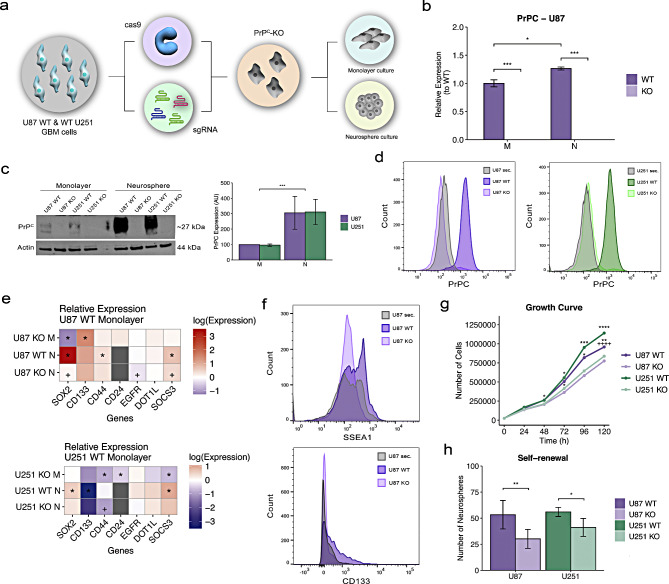Prion protein regulates invasiveness in glioblastoma stem cells.
BACKGROUND: Glioblastoma (GBM) is an aggressive brain tumor driven by glioblastoma stem cells (GSCs), which represent an appealing target for therapeutic interventions. The cellular prion protein (PrPC), a scaffold protein involved in diverse cellular processes, interacts with various membrane and extracellular matrix molecules, influencing tumor biology. Herein, we investigate the impact of PrPC expression on GBM. METHODS: To address this goal, we employed CRISPR-Cas9 technology to generate PrPC knockout (KO) glioblastoma cell lines, enabling detailed loss-of-function studies. Bulk RNA sequencing followed by differentially expressed gene and pathway enrichment analyses between U87 or U251 PrPC-wild-type (WT) cells and PrPC- nockout (KO) cells were used to identify pathways regulated by PrPC. Immunofluorescence assays were used to evaluate cellular morphology and protein distribution. For assessment of protein levels, Western blot and flow cytometry assays were employed. Transwell and growth curve assays were used to determine the impact of loss-of-PrPC in GBM invasiveness and proliferation, respectively. Single-cell RNA sequencing analysis of data from patient tumors from The Cancer Genome Atlas (TCGA) and the Broad Institute of Single-Cell Data Portal were used to evaluate the correspondence between our in vitro results and patient samples. RESULTS: Transcriptome analysis of PrPC-KO GBM cell lines revealed altered expression of genes associated with crucial tumor progression pathways, including migration, proliferation, and stemness. These findings were corroborated by assays that revealed impaired invasion, migration, proliferation, and self-renewal in PrPC-KO GBM cells, highlighting its critical role in sustaining tumor growth. Notably, loss-of-PrPC disrupted the expression and localization of key stemness markers, particularly CD44. Additionally, the modulation of PrPC levels through CD44 overexpression further emphasizes their regulatory role in these processes. CONCLUSIONS: These findings establish PrPC as a modulator of essential molecules on the cell surface of GSCs, highlighting its potential as a therapeutic target for GBM.
Authors
Prado MB, Coelho BP, Iglesia RP, Alves RN, Boccacino JM
External link
Publication Year
Publication Journal
Associeted Project
Systems Immunology of Human Diseases
Lista de serviços
-
RASL11A, member of a novel small monomeric GTPase gene family, is down-regulated in prostate tumors.RASL11A, member of a novel small monomeric GTPase gene family, is down-regulated in prostate tumors.
-
Splice variants of TLE family genes and up-regulation of a TLE3 isoform in prostate tumors.Splice variants of TLE family genes and up-regulation of a TLE3 isoform in prostate tumors.
-
Concepts on Microarray Design for Genome and Transcriptome AnalysesConcepts on Microarray Design for Genome and Transcriptome Analyses
-
The iron stimulon of Xylella fastidiosa includes genes for type IV pilus and colicin V-like bacteriocins.The iron stimulon of Xylella fastidiosa includes genes for type IV pilus and colicin V-like bacteriocins.
-
Origins of the Xylella fastidiosa prophage-like regions and their impact in genome differentiation.Origins of the Xylella fastidiosa prophage-like regions and their impact in genome differentiation.
-
The role of prophage in plant-pathogenic bacteria.The role of prophage in plant-pathogenic bacteria.
-
Genetic control of immune response and susceptibility to infectious diseases.Genetic control of immune response and susceptibility to infectious diseases.
-
Building capacity for advances in tuberculosis research; proceedings of the third RePORT international meeting.Building capacity for advances in tuberculosis research; proceedings of the third RePORT international meeting.
-
São Paulo School of Advanced Sciences on Vaccines: an overview.São Paulo School of Advanced Sciences on Vaccines: an overview.
-
A reasonable request for true data sharing.A reasonable request for true data sharing.

